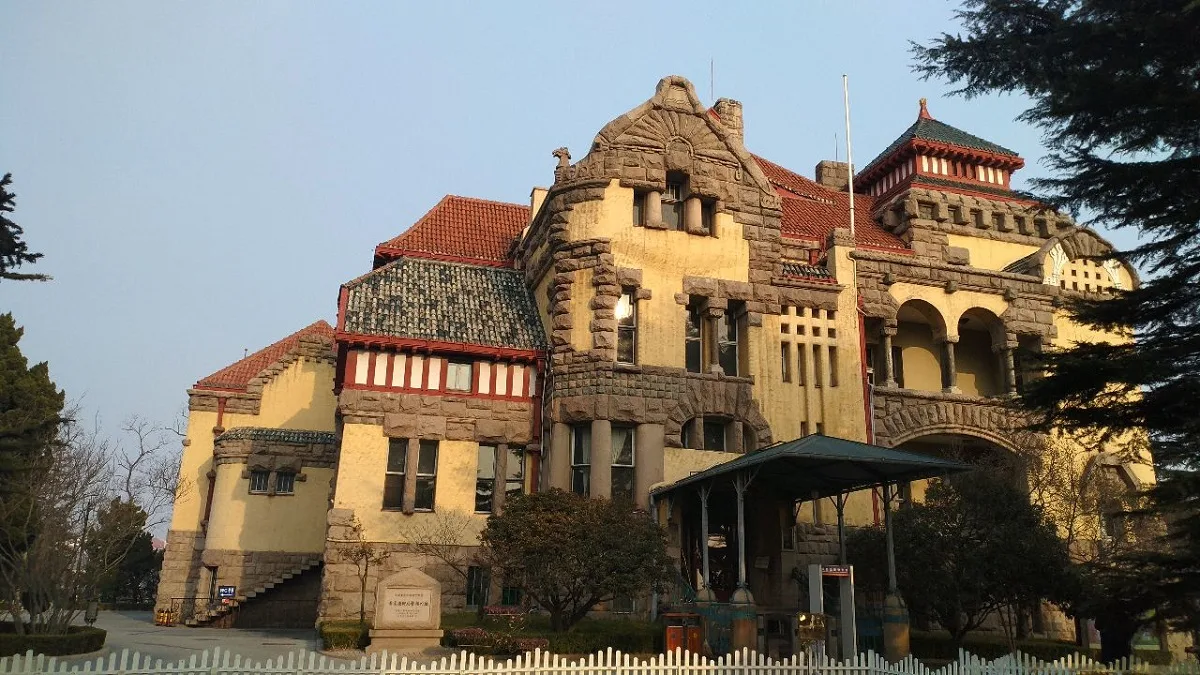The Site Museum of the Former German Governor’s Residence (德国总督楼旧址博物馆) is a typical example of German castle-style architecture. It was constructed in 1903 and completed in 1908, covering an area of over 4,000 square meters. Standing at over 30 meters tall, the building cost over one million marks to construct and was used as a high-level reception hotel in Qingdao. The building comprises four floors, with the ground floor consisting of semi-underground rooms, originally used by the governor’s servants but now converted into a café. The fourth floor serves as office space and is not open to the public, leaving only the second and third floors accessible for visitors.
This four-story structure is a mix of stone, steel, brick, and wood, boasting a unique and luxurious architectural style. Its exterior incorporates various artistic styles such as Gothic, Romanticism, Baroque, Roman, and Jugendstil, presenting a colorful and visually stunning appearance. The main facade on the west side rises 30 meters high, predominantly in yellow tones with granite decorations. Unlike traditional Chinese architecture, the main entrance of the building is located on the west side, echoing the position of the governor’s office building, and also following the tradition of many Romanesque cathedrals in Europe.
The interior is equally magnificent, with herringbone-patterned floors, finely carved wainscoting, and colorful wall and pendant lamps of various shapes. The walls of the bedrooms are adorned with silk fabric, and the rooms are furnished with German pianos, sofas, coffee tables, and bookcases, all of which are well-preserved to this day. The annex buildings, such as the indoor fountain fish pond, flower house, and places for raising pigeons and monkeys, also boast distinctive styles.
The history of this building is also rich and varied. In 1914, after Japan replaced Germany in occupying Qingdao, the governor’s office became the residence of the Japanese Qingdao garrison commander. At the end of 1922, the Chinese government regained control of Qingdao, and the governor’s office became the residence of the Inspector-General of the Jiaozhou Bay Leased Territory. In late 1925, Bi Shoucheng, the Chief of the Jiaodong Garrison, moved into the governor’s office but was executed by Zhang Zongchang in March 1927. Thereafter, the governor’s office was used for entertaining guests. In 1934, the governor’s office was officially renamed the “Guesthouse.” After the second Japanese occupation of Qingdao in 1938, it was briefly converted into an “International Club.” Following Japan’s surrender in 1945, it continued to serve as a “Guesthouse.” After the liberation of Qingdao in 1949, leaders of the party and state, including Mao Zedong, and some foreign dignitaries have stayed here.
Basic Information
| Estimated Length of Tour | 1 hour |
| Ticket Price | 20 RMB |
| Opening Hours | 9.00 – 17.00; |
| Telephone Number | 0086-0532-82865359 0086-0532-82868838 |
Location and Transportation
The Site Museum of the Former German Governor’s Residence is located at 26 Longshan Road, Shinan District, Qingdao City, Shandong Province. To get there, you can choose one of the following ways:
Bus: Take bus 217, 220, 221, or 411 Loop Line and get off at Longjiang Road University Road Stop (龙江路大学路站).
Metro: The closest metro station to the museum is Signal Hill (信号山) on line 4. After getting out of the station from Exit B2, walk abou 350 meters to the east to reach the attraction.







